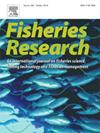Comparing top- and bottom-opening Nordmøre-grids in south-eastern Australian estuarine squid trawls
IF 2.2
2区 农林科学
Q2 FISHERIES
引用次数: 0
Abstract
In response to prolonged, regional jellyfish (mostly Catostylus mosaicus) blooms in the Hawkesbury River, south-eastern Australia, trawlers targeting broad squid, Uroteuthis sp. 3 and Luminous Bay squid, U. noctiluca have modified their trawls to include mechanical-separating devices, and mostly bottom-opening Nordmøre-grids. Three experiments were done here to incrementally assess the relative performances of Nordmøre-grids for maintaining squid and by-product (>35 mostly fish species) catches, while reducing jellyfish and other bycatch. The Nordmøre-grids had identical bar spaces (∼42 mm), sizes (1200 × 725 mm), installation angles (30°) and escape-exit designs (with a mesh cover) but were compared as (1) top- or bottom-opening orientations with long guiding panels in the extension, and then bottom-opening designs with either (2) long or short guiding panels or (3) short or no guiding panels. There were few significant differences in catches of key groups or species between any of the grids, reiterating the generic utility of the design for consistently separating out large unwanted organisms (i.e. jellyfish). Nevertheless, trawls with the top-opening design retained significantly fewer small- and medium-sized silver biddy, Gerres subfasciatus (a by-product species) and slightly less total by-product (attributed to a tendency for some fish to rise in the extension). Among the bottom-opening designs, using a short guiding panel and a modification involving opening meshes opposite the leading edge of the panel allowed one strong-swimming bycatch species (silver trevally, Pseudocaranx georgianus) to escape, although there were few other perceived benefits. While Nordmøre-grids permit squid trawling during moderate jellyfish blooms in the Hawkesbury River, alternative catching methods (e.g. jigging) might also warrant investigation for more holistically improving environmental efficiencies.
求助全文
约1分钟内获得全文
求助全文
来源期刊

Fisheries Research
农林科学-渔业
CiteScore
4.50
自引率
16.70%
发文量
294
审稿时长
15 weeks
期刊介绍:
This journal provides an international forum for the publication of papers in the areas of fisheries science, fishing technology, fisheries management and relevant socio-economics. The scope covers fisheries in salt, brackish and freshwater systems, and all aspects of associated ecology, environmental aspects of fisheries, and economics. Both theoretical and practical papers are acceptable, including laboratory and field experimental studies relevant to fisheries. Papers on the conservation of exploitable living resources are welcome. Review and Viewpoint articles are also published. As the specified areas inevitably impinge on and interrelate with each other, the approach of the journal is multidisciplinary, and authors are encouraged to emphasise the relevance of their own work to that of other disciplines. The journal is intended for fisheries scientists, biological oceanographers, gear technologists, economists, managers, administrators, policy makers and legislators.
 求助内容:
求助内容: 应助结果提醒方式:
应助结果提醒方式:


